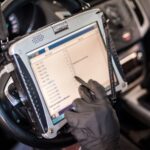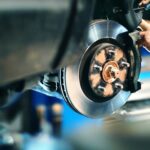
The integration of AEB is particularly useful in congested traffic conditions, where sudden stops are frequent. Drivers may not always be able to react quickly enough, but AEB fills that gap by responding faster than human reflexes. This timely response helps prevent rear-end collisions that could otherwise lead to significant damage or injury.
How AEB Works in Different Driving Conditions
AEB systems use a combination of sensors, radar, and cameras to monitor the road ahead. These sensors constantly assess the distance between vehicles, scanning for any objects or cars that may cause an impending collision. In ideal conditions, AEB can stop a car entirely before a crash occurs. However, in some situations, the system may only reduce the severity of the impact by slowing the vehicle down significantly before the crash.
AEB systems perform well in various driving conditions, from dry highways to rainy city streets. Even in adverse weather, AEB can provide an extra layer of protection by responding faster than human drivers. While not foolproof, AEB significantly enhances overall road safety, reducing the likelihood of rear-end collisions.
Reducing Human Error with AEB
One of the main benefits of AEB is its ability to reduce the impact of human error. Rear-end collisions often occur when drivers are distracted, fatigued, or simply fail to brake in time. AEB eliminates some of these risks by automatically intervening when a driver doesn’t react quickly enough. This automation can save lives and prevent injuries in cases where human reflexes may fall short.
As drivers rely on AEB, it’s important to remember that the system is a supplement to, not a replacement for, safe driving practices. While AEB reduces the chance of rear-end collisions, drivers must remain attentive and engaged on the road. In addition, understanding the limitations of AEB systems—such as performance in extreme weather conditions or on poorly maintained roads—is crucial for maximizing safety. Staying informed about updates and improvements to AEB technology can help drivers use it more effectively alongside responsible driving habits.
The Role of AEB in Legal Cases Involving Accidents
With the rise of AEB technology, questions about liability in car accidents have become more complex. In cases where AEB is involved in a rear-end collision, determining whether the driver or the technology failed can complicate the legal process. This is especially true if the system doesn’t activate as expected, leading to a crash.
For drivers involved in rear-end collisions, understanding their rights is critical. Those filing motor vehicle accident claims may need to consider the role that AEB played in the incident. Consulting with a lawyer experienced in these cases can help determine liability and ensure that injured parties receive the compensation they deserve.
AEB’s Impact on Insurance and Safety Ratings
The widespread adoption of AEB is having a positive impact on vehicle safety ratings and insurance premiums. Many insurance companies now offer discounts for vehicles equipped with AEB, recognizing the technology’s potential to reduce accidents and claims. In addition, cars with AEB often receive higher safety ratings from organizations like the Insurance Institute for Highway Safety (IIHS), making them more attractive to consumers.

As AEB technology continues to improve, insurance companies and safety organizations are likely to place even greater emphasis on its role in reducing rear-end collisions and overall road safety. In fact, some experts predict that AEB may become a standard feature in all vehicles, further incentivizing manufacturers to integrate the technology. This could lead to even broader benefits for drivers, including lower insurance premiums and enhanced vehicle marketability.
Enhancing AEB with Advanced Technologies
AEB is just one of many advanced driver assistance systems (ADAS) designed to improve road safety. When combined with other technologies, such as adaptive cruise control, lane departure warnings, and blind-spot monitoring, AEB becomes even more effective at preventing collisions. These systems work together to provide a comprehensive safety net, reducing the risk of accidents in various driving situations.
As manufacturers continue to integrate ADAS features into new vehicles, the combination of technologies like AEB will likely become standard, providing drivers with more tools to avoid collisions and drive safely. The future may also bring enhanced connectivity between vehicles, enabling ADAS systems to communicate with each other and further optimize collision prevention. This synergy between technologies has the potential to revolutionize road safety, making driving safer for everyone on the road.
The Role of AEB in Reducing Rear-End Accidents in Commercial Vehicles
Commercial vehicles, such as trucks and delivery vans, can benefit greatly from AEB technology. Rear-end collisions involving large vehicles are often severe due to their size and weight, resulting in significant property damage and injuries. By equipping commercial fleets with AEB systems, companies can reduce the risk of such accidents and protect both their drivers and others on the road.
Investing in AEB for commercial vehicles is also a cost-saving measure for businesses, as it helps avoid legal liability and the expenses associated with accidents, repairs, and insurance claims. Moreover, it can lead to reduced downtime, as fewer accidents mean fewer interruptions in operations and deliveries. This not only enhances safety but also improves the overall efficiency and reliability of the fleet.
The Future of AEB and Autonomous Driving
The future of AEB is closely tied to the development of autonomous vehicles. As automakers continue to push the boundaries of self-driving technology, AEB is expected to evolve into even more sophisticated systems capable of handling complex driving scenarios. Fully autonomous vehicles will rely on AEB and other safety technologies to navigate safely without human intervention.

As this technology develops, we can expect even fewer rear-end collisions, as automated systems will be able to prevent them in real-time. The continued refinement of AEB technology will play a key role in shaping the future of road safety.






































